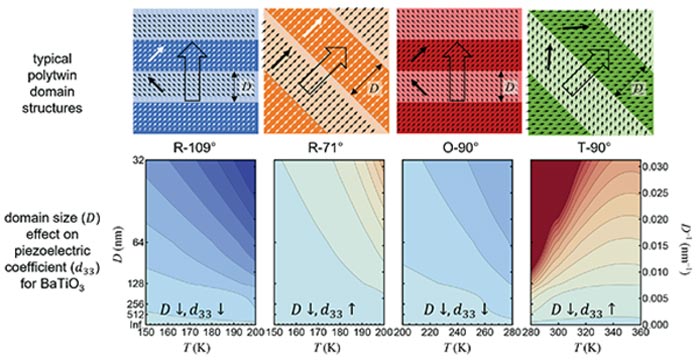Study challenges standard ideas about piezoelectricity in ferroelectric crystals

Schematics of domain structures of barium titanate single crystals (upper panel) and the corresponding piezoelectric coefficient as a function of the domain size and temperature (lower panel), which are calculated by phase-field simulations
Credit: Chane Research Group, Penn State
For years, researchers believed that the smaller the domain size in a ferroelectric crystal, the greater the piezoelectric properties of the material. However, recent findings by Penn State researchers have raised questions about this standard rule.
Ferroelectric materials possess spontaneous electric dipole moments that can be reversibly flipped by applying an electric field. Domains are areas in the ferroelectric crystal that have the dipole moments aligned in the same direction. Piezoelectricity is a material property where the crystal generates electrical charge under an applied mechanical force. This capability enables piezoelectrics to be used in electronics, sensors and actuators.
“So many devices in our daily life utilize the ability of a material to convert electrical signals to mechanical signals and vice versa,” said Bo Wang, postdoctoral scholar in materials science and engineering. “In most of these applications, the piezoelectric material plays a key role. And the most advanced piezoelectric materials are the ferroelectric materials.”
At a microscopic scale, ferroelectric materials consist of many domains, and these domains range in size from a few nanometers to as much as millimeters. Each domain consists of uniform or nearly uniform distribution of dipole moments, which occur when there is a separation of charge. The regions between adjacent domains are known as domain walls.
“The domain walls in ferroelectric crystals are interfaces with a very small thickness over which the dipole moments change their directions. It’s well known in the research community of ferroelectric materials that these domain walls have a strong influence on piezoelectricity,” Wang said. “There is a general belief in the community that the smaller the domain size or higher the domain wall density, the larger the piezoelectric coefficient.”
However, the recent work by Wang and his co-workers, published in Advanced Materials, challenges this conventional wisdom.
“Our theory and computation demonstrated that such a conventional view is actually not often correct,” Wang said.
The researchers found that the idea that smaller domains lead to higher piezoelectricity is based on very limited existing data without a solid theoretical foundation.
“Based on this conventional wisdom, many in the research community have tried to find ways to make all these domains smaller to enhance the piezoelectricity, and often when they see some improvement in the piezoelectric performance, one of the first things that comes to mind is maybe due to the smaller domains,” said Long-Qing Chen, Hamer Professor of Materials Science and Engineering, professor of engineering science and mechanics, and professor of mathematics at Penn State. “Our work provides a theoretical foundation for correlating the piezoelectricity to crystal symmetry, crystal orientation, and domain configuration.”
In that paper, they referred to findings by other researchers that an AC electric field can improve the piezoelectric response of the crystal by 20% to 40% compared with the crystal treated by a DC electric field. But the team discovered that inside the crystal during AC switching cycles, the domain sizes actually got bigger, not smaller as would be expected.
“We proposed a theoretical model of domain change under electric fields, we use computation to confirm it, and because of our simulation, we have shown that researchers in the future will have to look inside the crystal,” Chen said. “The previous researchers showed that higher piezoelectric response is due to smaller domains, but they only looked at the surface. We showed computationally that actually, the domains became bigger with higher piezoelectricity, and that was found by examining under the crystal’s surface.”
According to Wang, this new understanding of the relationship between ferroelectric crystal domain size and piezoelectricity can provide guidance to improve piezoelectric performance of materials.
“We hope that this study allows people to rethink the design principles for piezoelectric materials, perhaps creating better piezoelectric materials in ways that were not thought possible before,” Wang said. “This may enable better piezoelectrics made from lower-cost materials, or from materials that are more environmentally friendly.”
Along with Wang and Chen, the other author on the study was Fei Li, a previous postdoctoral researcher in materials science and engineering at Penn State and now a full professor at Xi’an Jiaotong University in China.
The National Science Foundation supported this research.
Journal: Advanced Materials
DOI: 10.1002/adma.202105071
Article Title: Inverse Domain-Size Dependence of Piezoelectricity in Ferroelectric Crystals
Article Publication Date: 15-Oct-2021
Media Contact
A’ndrea Messer
Penn State
aem1@psu.edu
Office: 814-865-9481
All latest news from the category: Materials Sciences
Materials management deals with the research, development, manufacturing and processing of raw and industrial materials. Key aspects here are biological and medical issues, which play an increasingly important role in this field.
innovations-report offers in-depth articles related to the development and application of materials and the structure and properties of new materials.
Newest articles

Innovative 3D printed scaffolds offer new hope for bone healing
Researchers at the Institute for Bioengineering of Catalonia have developed novel 3D printed PLA-CaP scaffolds that promote blood vessel formation, ensuring better healing and regeneration of bone tissue. Bone is…

The surprising role of gut infection in Alzheimer’s disease
ASU- and Banner Alzheimer’s Institute-led study implicates link between a common virus and the disease, which travels from the gut to the brain and may be a target for antiviral…

Molecular gardening: New enzymes discovered for protein modification pruning
How deubiquitinases USP53 and USP54 cleave long polyubiquitin chains and how the former is linked to liver disease in children. Deubiquitinases (DUBs) are enzymes used by cells to trim protein…



